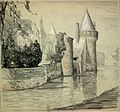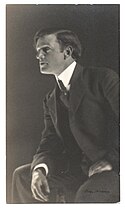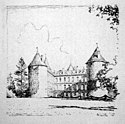Ernest Peixotto
Ernest Clifford Peixotto (* 15. Oktober 1869 in San Francisco; † 6. Dezember 1940 in New York) war ein amerikanischer Maler, Wandmaler, Illustrator und Autor. Als einer von acht Künstlern der American Expeditionary Force, war es im Ersten Weltkrieg Peixottos Aufgabe, den Krieg in Zeichnungen festzuhalten.
Leben
Familie und Karriere
Ernest Clifford Peixotto wurde am 15. Oktober 1869 in San Francisco, Kalifornien geboren. als dritter Sohn von fünf Kindern einer jüdischen Familie geboren. Sein Vater Raphael Levy Maduro Peixotto war Händler, seine Mutter war Myrtillie Jessica Davis.[1]
1886 besucht Peixotto das Mark Hopkins Institute of Art in San Francisco (heute: San Francisco Art Institute) und wird dort von Emil Carlsen unterrichtet. Dort befreundete er sich auch mit dem später bekannten Autor Frank Norris. Peixotto erregte zum ersten Mal Aufsehen in der San Francisco Kunstszene, als er für die Publikation „The Lark“ das Titelblatt illustrierte. Ab 1888 studierte Peixotto auf Ermutigung von Emil Carlsen hin in Paris an der Académie Julian. Dort unterrichteten ihn unter anderen Jules-Joseph Lefebvre und Jean-Joseph Benjamin-Constant.[2] Hier begegnete er seinem Freund Frank Norris erneut, der sich ebenfalls zu einem Studium an der Académie Julian entschieden hatte. Die beiden einte eine Leidenschaft für das Skizzieren von Artilleriegeräten und Waffen. 1890 und 1891 stellte Peixotto im Salon de Paris die beiden Gemälde „Le Vieux Garde de Chasse“ und „Dans l’Église“ aus und wurde daraufhin als aufsteigender Stern der Kunst in den USA gehandelt.[1]
Nach sechs Jahren in Frankreich kehrte Peixotto 1894 in die USA zurück, malte einige Jahre lang in San Francisco Porträts und begann 1897 beim Scribner’s Magazine und beim Harper’s Magazine in New York als Illustrator zu arbeiten. Hier arbeitete er auch als Illustrator an Henry Cabot Lodges „The Story of the Revolution“. Um alle im Buch genannten Orte der Revolution angemessen zu illustrieren, reiste Peixotto an alle Schauplätze.[1]
Peixotto heiratete 1897 Mary G. Hutchinson, eine Künstlerin, die in Paris auch unter Emil Carlsen studiert hatte. Zusammen reisten sie mehrere Jahre unter anderem durch Frankreich, Spanien, Portugal und Italien, später auch durch Südamerika. Nebenher schrieb er mehrere Artikel für das Scribner’s Magazine über seine Reiseerfahrungen. Mit den Erfahrungen dieser Reisen verfasste Peixotto mehrere Reisebücher, die er mit seinen Zeichnungen der dortigen Landschaft illustrierte.[1] Ab 1907 unterrichtete er kurzzeitig am Art Institute of Chicago.[1]
Zeit in der American Expeditionary Force
Mit Beginn des Ersten Weltkrieges brach Peixotto einen Aufenthalt in Frankreich ab und kehrte in die USA zurück.[3] Nach intensiver gedanklicher Auseinandersetzung mit dem Krieg, schloss er sich der Division of Pictorial Publicity unter Charles Dana Gibson an, deren Ziel es war die amerikanischen Bürger mit Propaganda für den Krieg zu begeistern. Mithilfe von Kunstwerken, die die heroische Aufopferung und den Mut von Soldaten zeigten, sollten die Amerikaner sich mit ihnen solidarisieren.[1]
Kurze Zeit später wurden Peixotto und sieben andere Maler (Wallace Morgan, William James Aylard, Harry Townsend, Harvey Dunn, Walter Jack Duncan, George Matthews Harding, Jules Andre Smith) der Division of Pictorial Publicity von John J. Pershing als Captains der Abteilung für Malerei zum United States Army Corps of Engineers berufen. Ihre Aufgabe wurde es, den Krieg in Bildern festzuhalten. Peixotto tat das meist in Form von Skizzen und Zeichnungen der zerstörten Landschaft und Architektur nach geschlagener Schlacht.[4]
Zeit nach dem Krieg
Nach Ende des Krieges verblieb Peixotto in Frankreich, nahe Paris als Leiter der Abteilung für Malerei in einem Trainingszentrum für Malerei der US-Army. Von 1919 bis 1926 war er zudem in New York Präsident der Abteilung Wandmalerei des Beaux-Arts Institute of Design. Ab 1924 konzentrierte sich Peixotto auf die Wandmalerei, es entstanden in mehreren Gebäuden New Yorks Wandgemälde, darunter 1924 auch in der Bank of New York. Von 1929 bis 1939 wird er Präsident der National Society of Mural Painters der USA.[1] 1937 wurde er in die American Academy of Arts and Letters gewählt.[5]
Am 6. Dezember 1940 verstirbt Peixotto in New York im Alter von 71 Jahren.
Werke
Bücher
- By Italian Seas (1906)
- Through the French Provinces (1909)
- Romantic California (1910)
- Pacific Shores from Panama (1913)
- Our Hispanic Southwest (1916)
- A Revolutionary Pilgrimage, being an Account of a Series of Visits to Battlegrounds & other Places made memorable by the War of the Revolution (1917)
- The American Front (1919)
- Through Spain and Portugal (1922)
- A Bacchic Pilgrimage: French Wines (1932)
Alle Bücher wurden von Peixotto selbst illustriert.
Buchillustrationen
- Samuel Jacques Brun(1896): Tales of Languedoc.
- Emma Frances Dawson (1897): An Itinerant House and other Stories.
- Robert Louis Stevenson (1897): Letters.
- Robert Howe Fletcher (1898): Ten Drawings in Cinatown.
- Henry Cabbot Lodge (1898): The Story of the Revolution.
- Agnes Repplier (1898): Philadelphia: The Place and the People.
- Charles Hemstreet (1899): Nooks and Corners of Old New York.
- Roosevelt, Theodore (1899): Life of Cromwell.
- Frederick Milton Willis (1903): The City of Is, and other Poems.
- Wharton, Edith (1905): Italian Backgrounds.
- Wallace Irwin(1906): Chinatown Ballads.
- Clayton Hamilton (1925): Wanderings.
Gemälde
- Le Vieux Garde de Chasse (Öl, 1890)
- Dans L’Église (Öl, 1891)
- Woman of Rijsoord (Öl, 1895)
- Lady in Yellow (Öl, 1900)
- The Dutch Birdcage (Öl, 1907)
- The Pool, La Granja (Öl, 1915)
Wandgemälde
- Wandgemälde „Morte d’Arthur“ in Cleveland, Ohio für Henry A. Everett (1911)
- Wandgemälde in der Seaman’s Bank in New York City (1924)
- Wandgemälde in der Bank of New York City in New York City (1924)
- Wandgemälde im Century Club in New York City (1924)
- Wandgemälde in San Mateo, Kalifornien für William B. Bourn (1925)
- Wandgemälde in Long Island, New York für Farris Russell (1929)
- Wandgemälde in Pasadena, Kalifornien für John C. Cravens (1930)
- Wandgemälde in Florenz, Italien für Timothy Spelman (1931)
- Wandgemälde in Washington D.C. für das George Washington Bicentenary (1932)
Skizzen
Der Großteil von Peixottos Werk besteht aus Landschaftsskizzen.
Literatur
- Ernest Clifford Peixotto (2010): American Artist: A Biography. Maryland: America Star Books. ISBN 978-1615827473.
- Ernest Clifford Peixotto (1919): The American Front. ISBN 9781437241327.
Weblinks
- Werke von Ernest C. Peixotto beim Smithsonian American Art Museum. Abgerufen am 27. Januar 2018.
- Skizzen von Kriegsschauplätzen von Ernest Peixotto. Abgerufen am 15. Februar 2018.
Einzelnachweise
- ↑ a b c d e f g California Art Research Archive: Ernest Peixotto. Biography and Works, 1869. In: California Art Project, vol. 9. Abgerufen am 5. Januar 2018.
- ↑ Paintings & Sculpture at the Nat. Academy of Design, Vol. 1: 1826–1925, S. 222. Abgerufen am 5. Januar 2018.
- ↑ The National Museum of American History: Picturing World War I: America’s First Official War Artists, 1918–1919 Abgerufen am 15..2018
- ↑ The American Front. Ernest Peixotto. Abgerufen am 15. Februar 2018
- ↑ Members: Ernest C. Peixotto. American Academy of Arts and Letters, abgerufen am 19. April 2019.
| Personendaten | |
|---|---|
| NAME | Peixotto, Ernest |
| ALTERNATIVNAMEN | Peixotto, Ernest Clifford (vollständiger Name) |
| KURZBESCHREIBUNG | US-amerikanischer Maler, Illustrator und Kriegsmaler |
| GEBURTSDATUM | 15. Oktober 1869 |
| GEBURTSORT | San Francisco, Kalifornien |
| STERBEDATUM | 6. Dezember 1940 |
| STERBEORT | New York, New York |
Auf dieser Seite verwendete Medien
A drawing by Ernest Peixotto published in Sunset, March 1903, upon his return from Italy.
A drawing by Ernest Peixotto published in Sunset, March 1903, upon his return from Italy.
"Avignon, city of the Popes". 1 drawing : pen and ink. Gift, Scribner Book store, January 1953.
A drawing by Ernest Peixotto published in Sunset, March 1903, upon his return from Italy. The 1899 City Hall was destroyed in the San Francisco earthquake and fire of 1906.
Depiction of the Cherokee attack on the retreating Fort Loudoun garrison in Monroe County, Tennessee, United States, in August 1760.
Autor/Urheber: Smithsonian Institution from United States, Lizenz: No restrictions
Description: Portrait of Peixotto in suit. Also identical photo mounted on board. Identification on verso (handwritten): Ernest C. Peixotto. Peixotto, Ernest, 1869-1940
Creator/Photographer: Oscar Maurer
Medium: Black and white photographic print
Dimensions: 17 cm x 10 cm
Date: c. 1915
Persistent URL: www.aaa.si.edu/collections/images/detail/ernest-peixotto-...
Repository: Archives of American Art
Collection: Charles Scribner's Sons Art Reference Department Records, c. 1865-1957
Accession number: aaa_charscrs_4315Autor/Urheber: Internet Archive Book Images, Lizenz: No restrictions
Identifier: outing53newy (find matches)
Title: Outing
Year: 1885 (1880s)
Authors:
Subjects: Leisure Sports Travel
Publisher: (New York : Outing Pub. Co.)
Contributing Library: Tisch Library
Digitizing Sponsor: Boston Library Consortium Member Libraries
View Book Page: Book Viewer
About This Book: Catalog Entry
View All Images: All Images From Book
Click here to view book online to see this illustration in context in a browseable online version of this book.
Text Appearing Before Image:
ociation is to meet the needs of everyboy and young man in its community, thenit must engage in large public enterprises.Fully a score of associations are now pro-moting public playgrounds in their respec-tive cities. The Association in every un-organized city should immediately makethis a part of its policy, for it is a need inevery city. The method of approach tothe problem may differ in each city, but WINNING THE WAGER We made a bet—such betting is no sin— In jocose vein we made a harmless bet. A box of gloves I wagered on the set. Against .... She, nodding, smiled—our friends were standing by— But in her smile, and in her roguish eye I saw what others missed; and strove to win. I won the set. Back from the net I stood,A ad looked, for payment, where my lady satWith sunshade resting gently on her hat.She raised her eyes; then slowly crossed the court.She stepped so close ....For lesser favors Knights have fought.I played again; but played in absent mood. — EDWIN IV. 1V1NS
Text Appearing After Image:
Drawn by Ernest C. Peixotto to illustrateAround Messina and Reggio. STILL CARRY WATER IN GREEK AMPHORA ON THEIR HEADS
Note About Images
Château de Moulin (unknown which of the towns named Moulin or Moulins it may be). 1 drawing : crayon. Gift, Scribner Book Store, January 1953.
Château de la Grange-Bléneau, Courpalay, France. 1 drawing : pen and ink. Gift, Scribner Book Store, January 1953.
Fortified town (possibly Saumur) by river, France. 1 drawing : crayon.
Autor/Urheber:
E. C. Peixotto
Identifier: harpersnew0104various (find matches)
Title: Harper's New Monthly Magazine Volume 104 December 1901 to May 1902
Year: 1902 (1900s)
Authors: various
Subjects:
Publisher: New York: Harper & Brothers Publishers
Contributing Library: Brigham Young University-Idaho, David O. McKay Library
Digitizing Sponsor: Brigham Young University-Idaho
View Book Page: Book Viewer
About This Book: Catalog Entry
View All Images: All Images From Book
Click here to view book online to see this illustration in context in a browseable online version of this book.
Text Appearing Before Image:
'
Text Appearing After Image:
gained with two sturdy fishermen to rowus out to San Fruttuoso. We took somecold luncheon with us, and had been care-ful to choose a calm day when the seawas like a sheet of glass. A few strong-strokes of the heavy oars and the stoutboat shot round the end of the promon-tory that protects Porto Fino from theopen sea. Though it was February, thesun was dancing on the water and theshade of a parasol was very acceptable. Soon the long sea front of the MonteFino lined into view—a stupendous en-filade of precipices, towering out of thewater like the huge round buttresses ofsome titanic castle. Not a spare ledgeon which to set foot, not a bit of soillodged in a chink where a shrub ortree could cling, one column succeedinganother with almost architectural preci-sion, eternally defying the force of thesea. For an hour we skirted these frown-ing cliffs, until suddenly, as if by magic,the rocky walls parted and disclosed atiny bay surrounded by mountains, with,at its farthermost extremity, a
Note About Images






















